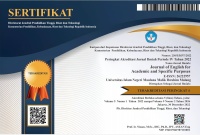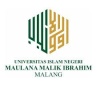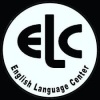THE EFFECTIVENESS OF MONOLOGUE INTEGRATED WITH WORD CARDS ON SPEAKING SKILL
Abstract
Speaking skill can be practiced in various ways. To master it, the researcher researched by using one of them by integrating it with word cards. The researcher used monologue integrated with word cards to investigate whether the integration was effective or not in increasing speaking skill. This study was restricted to the eleventh graders of the public upper level of secondary school. By using a one-group pre-test and post-test design, treatments were given to the 30 learners for six meetings. To achieve the aim of the study, two tests were constructed, in which a pre-test was given before while a post-test was given after the treatments. After the treatments finished, the scores of both tests were compared. The data analysis showed that the mean score of the pre-test was 42.3 while the post-test was 71.4 where tvalue = 31.753 with significance = .000 or ttabel of df = 29 with significance level .05 = 2.045, which means tvalue > ttabel or significance < .05. The result showed that the learners gained a significantly higher score in the post-test if it was compared to the one in the pre-test. It means that monologue integrated with word cards was effective in increasing speaking skill.
Full Text:
PDFReferences
Aitchison, J. (2003). Words in the mind (3rd Edition). Malden, MA: Blackwell.
Bilbrough, N. (2007). Dialogue activities. Cambridge: Cambridge University Press.
Brown, H.D. (2001). Teaching by principles: an interactive approach to language pedagogy. (2nd Edition). White Plains, NY: Pearson Education
Brown, H.D. (2004). Language assessment: Principles and classroom practices. White Plains, NY: Pearson Education.
Brown, H.D. (2007). teaching by principles: An interactive approach to language pedagogy (3rd Edition). White Plains, NY: Pearson Education.
Davis, J. (2007). Dialogue, monologue and soliloquy in the large lecture class. International Journal of Teaching and Learning in Higher Education 2007, 19(2), 178-182. Retrieved from http://www.isetl.org/ijtlhe
Firmansyah, Sudarsono, Rosnija, E. (2014) Teaching speaking narrative monologue by using shrinking story strategy. Jurnal Pendidikan dan Pembelajaran Khatulistiwa, 3(12). Retrieved from http://jurnal.untan.ac.id/index.php/jpdpb/article/view/8459
Heaton., JB. (1998). Writing English language. New York: Longman Inc.
Koizumi, R. & In’nami, Y. (2013). Vocabulary knowledge and speaking proficiency among second language learners from novice to intermediate levels. Journal of Language Teaching and Research, 4(5), 900-913. Retrieved from http://www.academypublication.com/issues/past/jltr/vol04/05/02.pdf
Krisdiana, B. P. (2017). The effectiveness of role-play integrated with word cards on learners’ speaking skill for communication. Unpublished Thesis. Malang: Universitas Negeri Malang.
Krisdiana, B. P., Irrawati, E., Kadarisman, A. E. (2018). The effectiveness of role-play integrated with word cards on learners’ speaking skill for communication. Jurnal Pendidikan Humaniora, 6(2), 78-84.
Kumaravadivelu, B. (2006). Understanding language teaching: From method to post-method. London: Lawrence Erlbaum Associates.
Latief, M. A. (2013). Research methods on language learning an introduction. Malang: UM Press.
Lavoie, C. (2016). The effect of training on vocabulary strategy use: Explicit teaching of word family, word network and word card strategies. The Journal of Language Teaching and Learning, 6(1), 20-34. Retrieved from https://gazi.academia.edu/TheJournalofLanguageTeachingandLearningJLTL
Meilyaningsih, A. I. (2014) Improving the students’ speaking ability through the use of role playing technique for grade viii students of SMPN 1 Banguntapan in the academic year of 2013/2014. Unpublished Thesis. Yogyakarta: Universitas Negeri Yogyakarta.
Morozova, Y. (2013). Methods of enhancing speaking skills of elementary level learners. Translation Journal, 17(1), Retrieved from http://translationjournal.net/journal/63learning.htm
Nunan, D. (1992). Research methods in language learning. Cambridge: Cambridge University Press.
Nunan, D. (2003). Practical English language teaching. NY: McGraw-Hill.
Offner, M. D. (1997). Teaching English conversation in Japan: Teaching how to learn. The Internet TESL Journal, 3(3). Retrieved from http://www.aitech.ac.jp/~offner/
Richek, M. A. (2005). Words are wonderful: Interactive, time-efficient strategies to teach meaning vocabulary. International Reading Association, 58(5): 414-323.
Ur, P. (1996). A course in language teaching: Practice and theory. Cambridge: Cambridge University Press.
Willis, J. (1982). Teaching English through English: A course in classroom language and techniques. Harlow: Pearson Education Limited.
DOI: https://doi.org/10.18860/jeasp.v3i2.11121
Refbacks
- There are currently no refbacks.

This work is licensed under a Creative Commons Attribution-ShareAlike 4.0 International License.






Editorial Office:
Pusat Pengembangan Bahasa
Program Khusus Pengembangan Bahasa Inggris (PKPBI)
Universitas Islam Negeri Maulana Malik Ibrahim Malang
Gedung C lantai 1
Jl. Gajayana No 50 Kota Malang, Jawa Timur, Indonesia
Kode Pos 65144, Telp/Fax : (0341) 570872
Email: jeasp@uin-malang.ac.id
JEASP : Journal of English for Academic and Specific Purposes is licensed under a Creative Commons Attribution-ShareAlike 4.0 International












